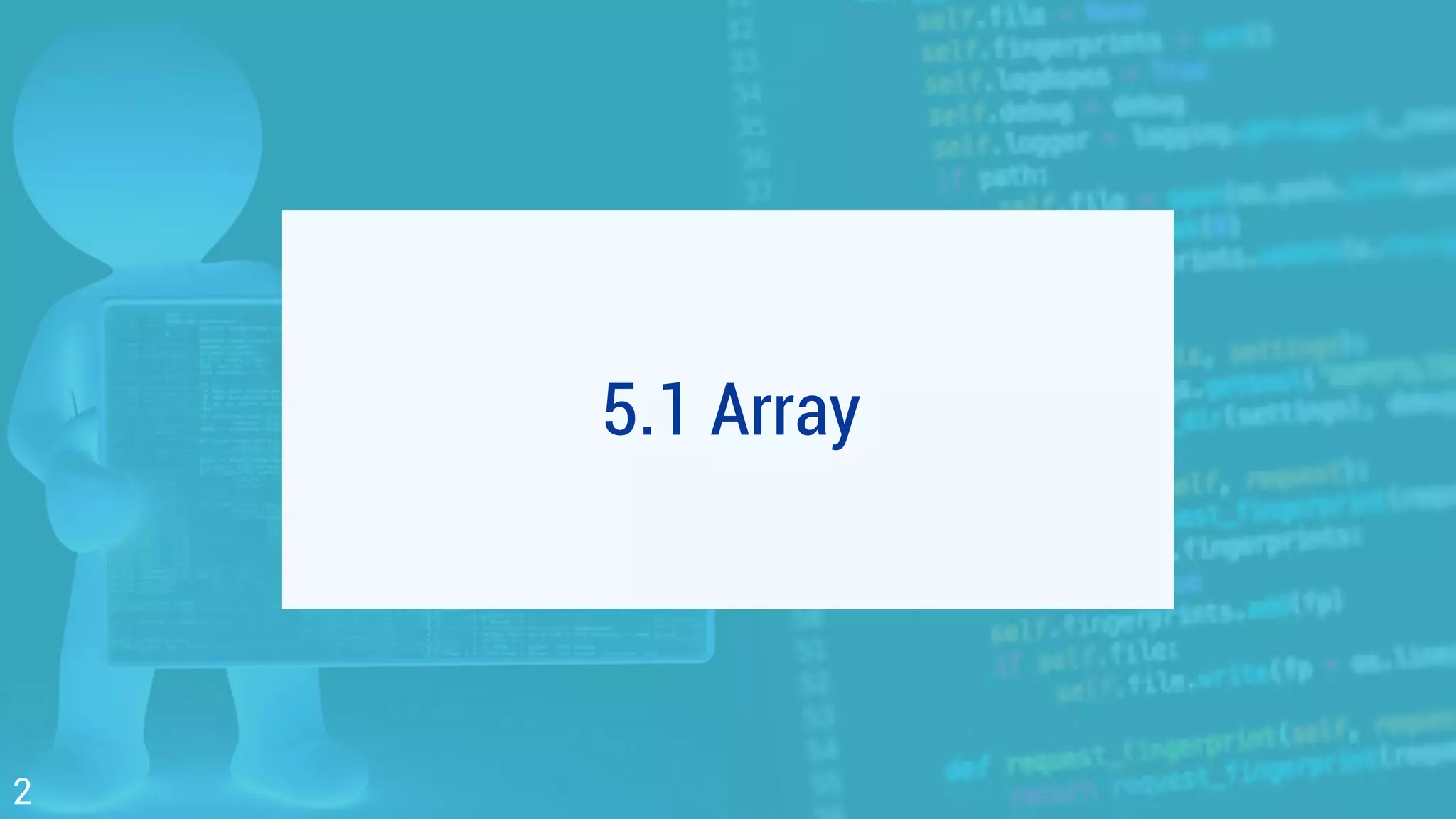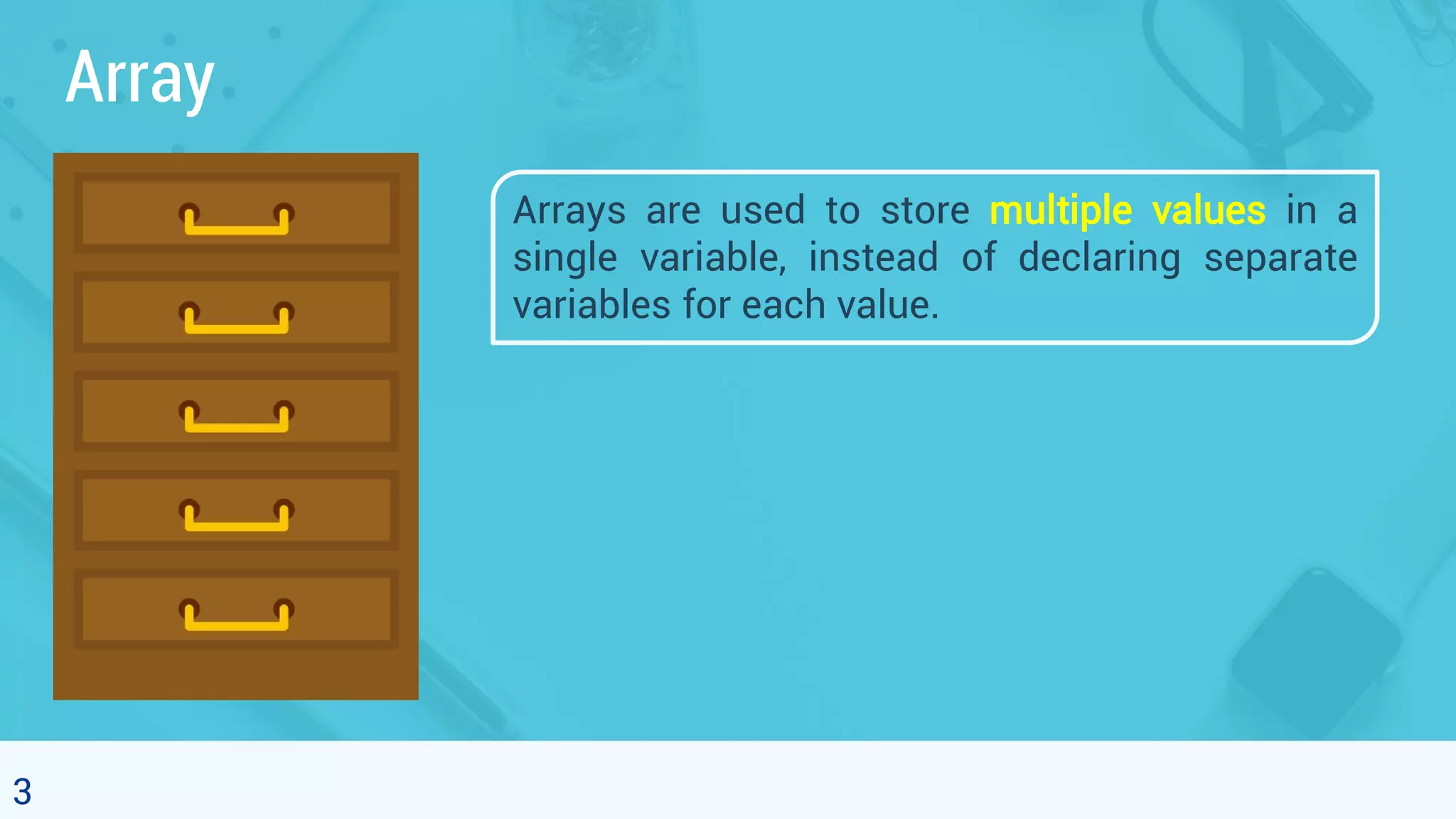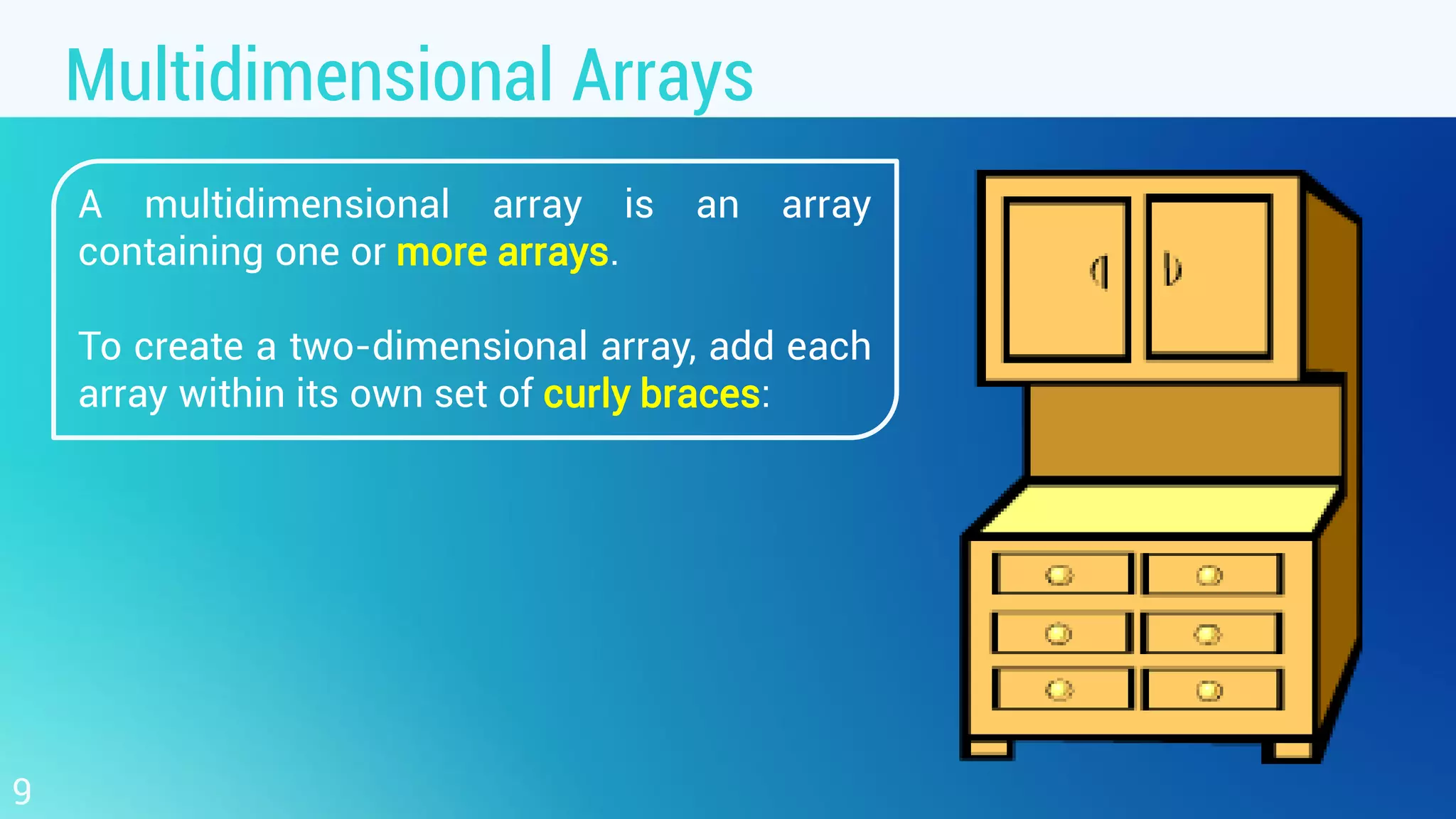This document discusses arrays in Java. It defines an array as a way to store multiple values in a single variable instead of separate variables. It explains how to declare and initialize arrays in Java, access array elements, change element values, determine the length of an array, loop through an array, and create multidimensional arrays. The document also discusses passing arrays to methods and using a foreach loop to traverse an array.



![Java Array 4 In Java, to declare an array, define the variable type with square brackets: String[] cars; To insert values to it, we can use an array literal - place the values in a comma-separated list, inside curly braces: String[] cars = {"Volvo", "BMW", "Ford", "Mazda"};](https://image.slidesharecdn.com/5-200318034327/75/Object-Oriented-Programming-5-1-Array-4-2048.jpg)
![Access the Elements of an Array You access an array element by referring to the index number. This statement accesses the value of the first element in cars: 5 String[] cars = {"Volvo", "BMW", "Ford", "Mazda"}; System.out.println(cars[0]); // Outputs Volvo](https://image.slidesharecdn.com/5-200318034327/75/Object-Oriented-Programming-5-1-Array-5-2048.jpg)
![Change an Array Element 6 To change the value of a specific element, refer to the index number: String[] cars = {"Volvo", "BMW", "Ford", "Mazda"}; cars[0] = "Opel"; System.out.println(cars[0]); // Now outputs Opel instead of Volvo](https://image.slidesharecdn.com/5-200318034327/75/Object-Oriented-Programming-5-1-Array-6-2048.jpg)
![7 Array Length To find out how many elements an array has, use the length property: String[] cars = {"Volvo", "BMW", "Ford", "Mazda"}; System.out.println(cars.length); // Outputs 4](https://image.slidesharecdn.com/5-200318034327/75/Object-Oriented-Programming-5-1-Array-7-2048.jpg)
![Loop Through an Array 8 You can loop through the array elements with the for loop, and use the length property to specify how many times the loop should run. The following example outputs all elements in the cars array: String[] cars = {"Volvo", "BMW", "Ford", "Mazda"}; for (int i = 0; i < cars.length; i++) { System.out.println(cars[i]); } // Outputs Volvo, BMW, Ford, Mazda](https://image.slidesharecdn.com/5-200318034327/75/Object-Oriented-Programming-5-1-Array-8-2048.jpg)

![Access the Element of an Array 10 To access the elements of the myNumbers array, specify two indexes: one for the array, and one for the element inside that array. This example accesses the third element (2) in the second array (1) of myNumbers: int[][] myNumbers = { {1, 2, 3, 4}, {5, 6, 7} }; int x = myNumbers[1][2]; System.out.println(x); // Outputs 7](https://image.slidesharecdn.com/5-200318034327/75/Object-Oriented-Programming-5-1-Array-10-2048.jpg)
![11 Loop Through an Array public class MyClass { public static void main(String[] args) { int[][] myNumbers = { {1, 2, 3, 4}, {5, 6, 7} }; for (int i = 0; i < myNumbers.length; ++i) { for(int j = 0; j < myNumbers[i].length; ++j) { System.out.println(myNumbers[i][j]); } } } }](https://image.slidesharecdn.com/5-200318034327/75/Object-Oriented-Programming-5-1-Array-11-2048.jpg)

![Create an Array 13 You can create an array by using the new operator with the following syntax: arrayRefVar = new dataType[arraySize]; The above statement does two things: • It creates an array using new dataType[arraySize]. • It assigns the reference of the newly created array to the variable arrayRefVar. dataType arrayRefVar[];](https://image.slidesharecdn.com/5-200318034327/75/Object-Oriented-Programming-5-1-Array-13-2048.jpg)
![Multidimensional Arrays double[] myList = new double[10]; 14](https://image.slidesharecdn.com/5-200318034327/75/Object-Oriented-Programming-5-1-Array-14-2048.jpg)
![The Foreach Loops 15 JDK 1.5 introduced a new for loop known as foreach loop or enhanced for loop, which enables you to traverse the complete array sequentially without using an index variable. int[][] myNumbers = { {1, 2, 3, 4}, {5, 6, 7} }; int x = myNumbers[1][2]; System.out.println(x); // Outputs 7](https://image.slidesharecdn.com/5-200318034327/75/Object-Oriented-Programming-5-1-Array-15-2048.jpg)
![16 Example public class TestArray { public static void main(String[] args) { double[] myList = {1.9, 2.9, 3.4, 3.5}; // Print all the array elements for (double element: myList) { System.out.println(element); } } }](https://image.slidesharecdn.com/5-200318034327/75/Object-Oriented-Programming-5-1-Array-16-2048.jpg)
![Passing Arrays to Methods 17 public static void printArray(int[] array) { for (int i = 0; i < array.length; i++) { System.out.print(array[i] + " "); } } //printArray(new int[]{3, 1, 2, 6, 4, 2}); Just as you can pass primitive type values to methods, you can also pass arrays to methods. For example, the following method displays the elements in an int array:](https://image.slidesharecdn.com/5-200318034327/75/Object-Oriented-Programming-5-1-Array-17-2048.jpg)
